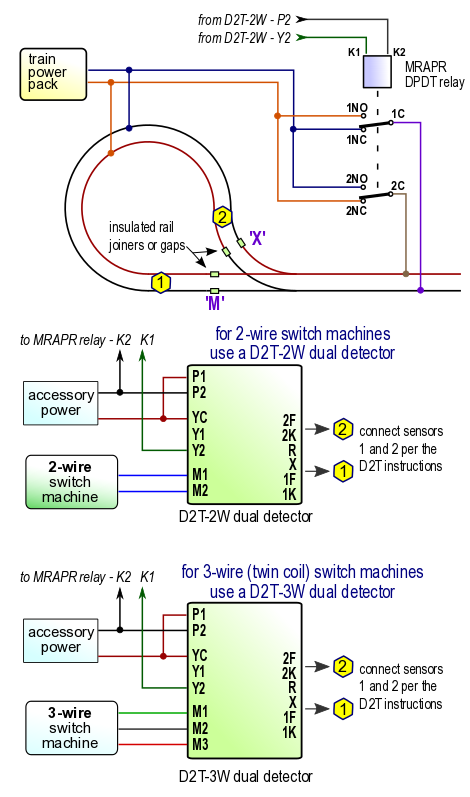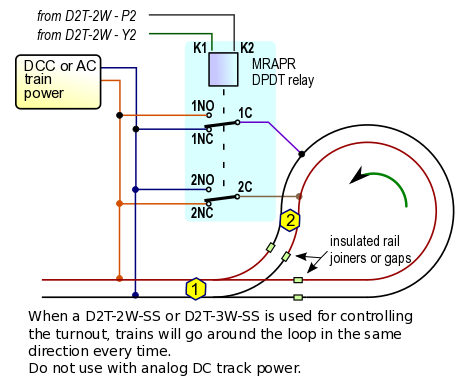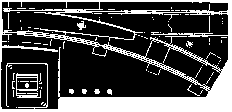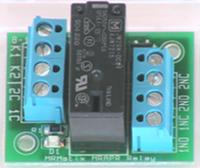|
|
|
|
|
Model Railway Single Reverse Loop Wiring
How to wire a single reverse loop on your two-rail layout for automatic operation
|
Two-rail model train layouts require special treatment of reverse loops. Wiring a reversing loop (or turn-around track) may seem complicated, but if you take one step at a time and check your work, you will have a fully automated reverse loop and worry-free train operation.
[Click here to review reverse loop fundamentals]
Here is a plan for a single 'tear drop' reversing loop:
This system is completely automated. Trains alternate their direction of travel each time they go around the loop. The switch machine is powered by the D2T-2W or D2T-3W dual IR detector.
This system, shown at right, uses a DPDT relay to control polarity of the main line.
When the relay is 'off' the main line polarity will match the loop polarity at point 'M', allowing trains to cross there.
• Click here to learn how a relay works. [pdf]
When the relay is 'on' the main line polarity will match the loop polarity at point 'X', allowing trains to cross at that end of the loop.
The relay turns on and off as the track switch points are changed from left to right. The relay and the switch machine are operated automatically by the
D2T-2W
(or -3W)
dual train detector
, so there is no need to manually change the loop track polarity.
Wire the switch machine so the switch points are aligned for the left track when sensor #1 is triggered. If the points align the wrong way, swap the connections to the switch machine.
How it works: Assume a train is moving right-to-left on the main track, approaching the loop, and the turnout is set to the left.
It enters the loop and travels clockwise. When it triggers sensor #2, the D2T-2W
(or -3W)
will throw the switch points to the right and turn on the relay. The main line and loop track polarities will now match at point 'X'. The train returns to the main line.
Now the next train approaches the loop, moving right-to-left. The switch points are still aligned to the right and the track polarities match at point 'X'.
The train travels counter-clockwise around the loop and triggers sensor #1. The D2T-2W
(or -3W)
throws the switch points to align with the left track and turns off the relay. Mainline and loop track polarities now match at point 'M' and the train returns to the main line.
Using the standard D2T-2W or -3W turnout control, trains will take alternating directions around the reversing loop
(clockwise & counter-clockwise).
Manual control of the turnout is possible, as shown in the
D2T-2W installation instructions and the
D2T-3W installation instructions.
For DCC powered layouts and AC layouts with a single train transformer this is all you need.
For DC layouts there is a catch. With DC power, track polarity determines train direction. If the turnout is manually thrown, a train moving on the main line will change direction! To avoid this, you can either:
• Not use manual turnout control, or
• stop the train before changing the turnout.
|

Controlling the track switch with a standard D2T-2W or -3W as shown above results in trains taking alternate directions around the loop. One train will go around clockwise, the next will go around counter-clockwise,
and so on.
For DCC and AC track power only:
To have all trains go around the loop in the same direction, choose a
D2T-2W-SS
or
D2T-3W-SS
(spring switch version) to control the track switch.
Note the location of sensor #1 as shown below:

The switch points are normally lined for the straight track. When a train is about to exit the loop, it trips sensor #2 and the switch points will line for the curve track.
The switch will return to the straight position after the end of the train clears sensor #1.
|
D2T-2W turnout control for 2-wire switch machines
Two-wire switch machines include single-coil 'snap' switches such as Kato™, LGB™ and Aristocraft™
as well as slow motion switch machines such as
Tortoise™, Cobalt Classic™ and SwitchMaster™
|
|
|
|
D2T-3W turnout control for 3-wire switch machines
Three-wire switch machines, also known as twin-coil or dual-solenoid switch machines, include Atlas™, Bachmann™, Kemtron™, Peco™ and American Flyer™.

|
|
|
|

|
MRAPR-12v DPDT relay
coil voltage 10 - 17v AC or DC
contacts rated for up to 8 amps
|
|
[ Choose a different type of reversing track ]
© copyright 2009-2020 Azatrax LLC, Longmont, Colorado
|
|




